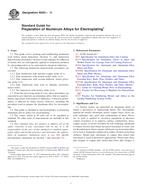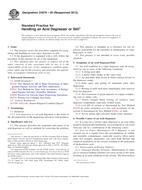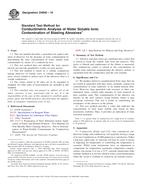Potřebujeme váš souhlas k využití jednotlivých dat, aby se vám mimo jiné mohly ukazovat informace týkající se vašich zájmů. Souhlas udělíte kliknutím na tlačítko „OK“.
ASTM B253-11
Standard Guide for Preparation of Aluminum Alloys for Electroplating
Automaticky přeložený název:
Standardní Příručka pro přípravu hliníkových slitin pro halvanické
NORMA vydána dne 15.12.2011
Informace o normě:
Označení normy: ASTM B253-11
Poznámka: NEPLATNÁ
Datum vydání normy: 15.12.2011
Kód zboží: NS-5984
Počet stran: 7
Přibližná hmotnost: 21 g (0.05 liber)
Země: Americká technická norma
Kategorie: Technické normy ASTM
Kategorie - podobné normy:
Anotace textu normy ASTM B253-11 :
Keywords:
Aluminum alloys, Brass electrodeposition, Cadmium metals (coating/plating), Chromium electroplating, Electrodeposited Cu coatings, Electrodeposited gold coatings, Electroplated coatings, Nickel coatings, Silver (electrodeposited), Specimen preparation (general)--electroplating, Tin metals/alloys--electrodeposited coatings, Zincate process, Zinc electrodeposited coatings, ICS Number Code 25.220.10 (Surface preparation)
Doplňující informace
| Significance and Use | ||||||||||||||||||
|
Various metals are deposited on aluminum alloys to obtain a decorative or engineering finish. The electroplates applied are usually chromium, nickel, copper, brass, silver, tin, lead, cadmium, zinc, gold, and combinations of these. Silver, tin, or gold is applied to electrical equipment to decrease contact resistance or to improve surface conductivity; brass, copper, nickel, or tin for assembly by soft soldering; chromium to reduce friction and obtain increased resistance to wear; zinc for threaded parts where organic lubricants are not permissible; tin or lead is frequently employed to reduce friction on bearing surfaces. Nickel plus chromium or copper plus nickel plus chromium is used in decorative applications. Nickel plus brass plus lacquer or copper plus nickel plus brass plus lacquer is also used for decorative finishes, sometimes with the brass oxidized and relieved in various ways. Electroless nickel may be applied as a barrier layer prior to other deposits, or for engineering purposes. The preparation of aluminum and aluminum alloy mandrels for electroforming is described in Practice . |
||||||||||||||||||
| 1. Scope | ||||||||||||||||||
|
1.1 This guide covers cleaning and conditioning treatments used before metal deposition (Section 5), and immersion deposit/strike procedures (Section 6) that enhance the adhesion of metals that are subsequently applied to aluminum products by electrodeposition or by autocatalytic chemical reduction. 1.2 The following immersion deposit/strike procedures are covered: 1.2.1 Zinc immersion with optional copper strike (6.3). 1.2.2 Zinc immersion with neutral nickel strike (6.4). 1.2.3 Zinc immersion with acetate-buffered, nickel glycolate strike (6.5). 1.2.4 Zinc immersion with acid or alkaline electroless nickel strike. 1.2.5 Tin immersion with bronze strike (6.6). 1.3 From the processing point of view, these procedures are expected to give deposits on aluminum alloys that are approximately equivalent with respect to adherence. Corrosion performance is affected by many factors, however, including the procedure used to prepare the aluminum alloy for electroplating. 1.4 This guide is intended to aid electroplaters in preparing aluminum and its alloys for electroplating. 1.5 The values stated in SI units are to be regarded as standard. No other units of measurement are included in this standard. 1.6 This standard does not purport to address all of the safety concerns, if any, associated with its use. It is the responsibility of the user of this standard to establish appropriate safety and health practices and determine the applicability of regulatory limitations prior to use. For specific precautionary statements see Section 7 and Appendix X1. |
||||||||||||||||||
| 2. Referenced Documents | ||||||||||||||||||
|
Podobné normy:
Historická
1.11.2010
Historická
1.9.2009
Historická
1.3.2012
Historická
1.3.2012
Historická
1.6.2010
Historická
1.6.2013
Doporučujeme:
Aktualizace technických norem
Chcete mít jistotu, že používáte pouze platné technické normy?
Nabízíme Vám řešení, které Vám zajistí měsíční přehled o aktuálnosti norem, které používáte.
Chcete vědět více informací? Podívejte se na tuto stránku.



 ASTM B480-88(2010)..
ASTM B480-88(2010).. ASTM B727-04(2009)..
ASTM B727-04(2009).. ASTM D4376-02(2012)..
ASTM D4376-02(2012).. ASTM D4579-00(2012)..
ASTM D4579-00(2012).. ASTM D4940-10
ASTM D4940-10 ASTM D5703-95(2013)..
ASTM D5703-95(2013)..
 Cookies
Cookies
